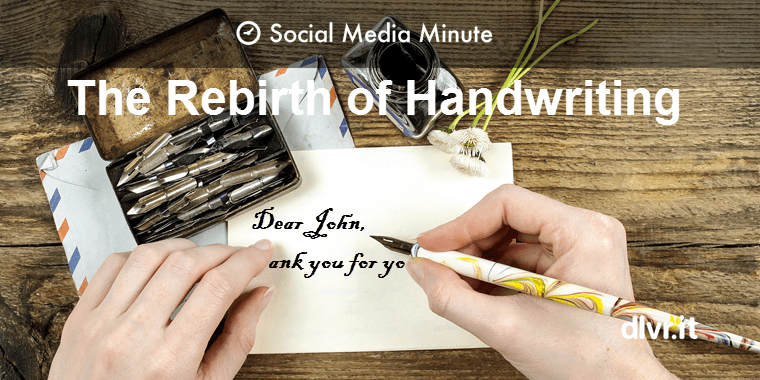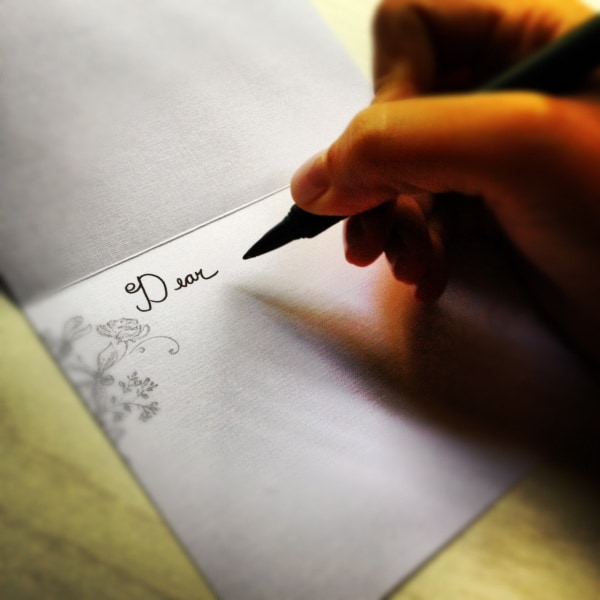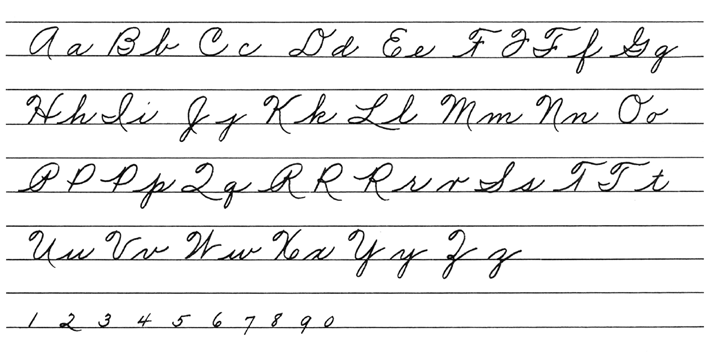
Social Media is Killing Handwriting and Why that’s Bad for Business
Do you remember learning to write in cursive; repeating letters across a wide-ruled notebook? How about today; can you write a legible thank you note? Social media seems to have ruined our collective handwriting ability. Why?
Very few people take the time to pick up pen and paper to express their gratitude. Technology is killing the personal touch. Most people would rather text or email to convey their thanks. While it is fast and efficient, technology lacks any sort of personal connection.
Do we still need handwriting in a digital world? Of course we do!
Myth #1: Once the Palmer Method of penmanship is drilled into you in Catholic school, you will always have beautiful handwriting.
Debunking Myth #1: Regardless of the years you may have spent in Catholic school diligently laboring to perfect the Palmer Method, your handwriting today (albeit 40 years later), may be horrible. Speaking from my Catholic schoolgirl experience, for many years my handwriting was fairly good. As life got busier and email, text and social media took over my pen and paper, my handwriting today has become a hybrid of cursive and print. (However, I do believe with a little practice and maybe instruction from a video on How to Improve Handwriting, I may be able to evolve my handwriting into a decent script.)
Myth #2: Handwritten notes are less important in our lives than they have ever been.
Personal handwritten notes grow rarer by the day. According to the U.S. Postal Service’s annual survey, the average home only received a personal letter once every seven weeks in 2010, down from once every two weeks in 1987. Some might claim that in a wired social media world — where emails, tweets, and text messages are more accessible than handwritten notes — this is the natural evolution of communication. Who has time for stamps, stationery, and “manual” spell-check, after all?
If you agree with these sentiments, you may believe that handwritten notes are a waste of time. However, you need to keep reading…

One thing my mother taught me was the importance of sending personal handwritten notes. She would be livid if I did not send thank you notes within a week after my birthday party or responded to a letter from my cousin or grandparents before month’s end. Currently, I am still reminded of the value of sending a personal note. While sitting on the board of directors for the Sonoma Valley Education Foundation, the executive director has the board hand sign every donation letter and, when possible, include a short note of thanks and appreciation to our donors. I’ve personally signed somewhere north of 5,000 letters during my tenure. This personalization has proven effective in keeping our donors aware of our personal interest and sincere appreciation.
Regarding communications, I have come to know two important things:
- Trust your mom’s suggestions as she is always right, and, more importantly,
- Keeping the lost art of sending handwritten thank you notes alive is more important than ever.
Why are handwritten notes so important?
The handwritten note is an especially important means of communication in both the personal and professional worlds. It not only strengthens the bonds between people, it also rings an emotional chord. If you want to build or maintain relationships, not to mention profit in your small business, you need to understand the value of writing notes by hand.
If your goal is to stand out from your competition, be noticed and be remembered, the simple act of writing a note to your potential or current client or to a business colleague will help you to accomplish just that.
To prove this point even further, here is a quote from an employer referenced in a New York Times article on The Found Art of Thank You Notes:
Heather Wiese, owner of Bell’Invito, a luxury stationer in Dallas, said, “If you want to stand out, to be more polished, probably the easiest thing you can do is write that thank you note.” She added: “Social media, texting and email are all completely relevant. But if after I’ve put my effort forward to interview a potential employee what I get is an email that looks exactly like 200 others, I may miss it.”
The following taken from the article Is the Handwritten Thank You Note a Lost Art, is a great primer on when, where, what and how you should write a thank you note.
When should you write a thank you note?
- Whenever someone takes more than fifteen minutes to do something for you. You may simply receive the gift of someone’s time, his or her advice, a helping hand or an online mention. Whenever another person does something thoughtful, return the favor with a small gift of your time by writing a note. You would be surprised to learn how many people save these notes.
- Whenever you receive a gift, a handwritten thank you note is the only acceptable response. Forget sending an email or texting. Send a personal acknowledgement.
- Whenever you receive an introduction to a potential client, a handwritten thank you note is in order.
- Whenever someone gives you the gift of his or her time to meet with you, send that handwritten note. And always write to thank the person who has hosted you to a meal.
What are the rules for sending a proper handwritten thank you note?
- Be brief. That is probably the good news. It need not take all day. A handwritten thank you does not need to be lengthy. If that is what is holding you back, get over it. Your note does not need to exceed three or four sentences.
- Use appropriate stationary that reflects your brand or personality. A single-sided correspondence card works as well as a fold-over note. If you are writing a note to a business client or associate, use a card or note that reflects your personal brand.
- Write your note in your own handwriting. At this point, most people use the excuse that their handwriting is unattractive or just plain illegible. It doesn’t matter. People do not judge you by your handwriting; but by your personal effort.
What is a simple formula to help you create a handwritten thank you note?
- Use an appropriate greeting. Begin with “Dear Mr. Jones” if this is your first time corresponding. Never use a client’s first name until you have permission. If you know the person and are on a first name basis, say, “Hi John,” or Hello John.” Always begin by using the person’s name or title and name.
- Acknowledge the gift or the event specifically. Say, “Thank you for the book,” or “Thank you for lunch.”
- Mention how you will use the gift or remember the event. “I will enjoy reading the book and am sure that it will be useful.” For lunch or dinner, write about how much you enjoyed that particular restaurant—calling it by name—and describing a specific aspect of the meal or conversation.
- Close with another thank you. Don’t feel you are overdoing it to repeat your appreciation. You are reinforcing your gratitude.
- Use an appropriate closing. Depending upon your relationship, use the words, “Regards,” “Sincerely,” “All the best,” or whatever feels comfortable for the situation.
Last tip: Keep your thank you notes or correspondence cards close at hand along with stamps. That will make it easy for you to return to your office and dash off a thank you without delay.



